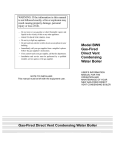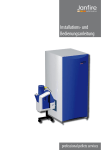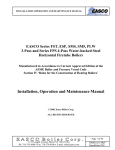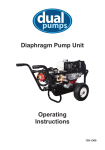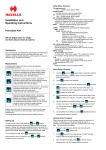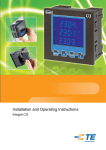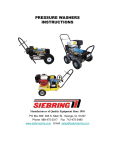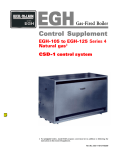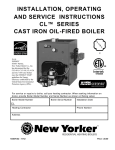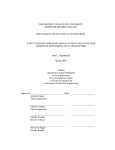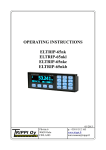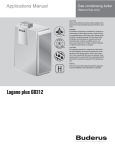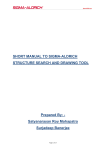Download Wood Pellet Cast Iron Boiler MESys 4000
Transcript
Operating Instructions Manual Wood Pellet Cast Iron Boiler MESys 4000 - 6000 Series Distributed by Maine Energy Systems Caution! Observe the safety instructions of this installation and maintenance manual before placing the boiler in operation. Danger! All installation, burner set-up and adjustment, and maintenance operations must be performed by a licensed service professional. The directions of this installation and maintenance manual must be followed precisely. Contact a qualified service company or service provider if support or additional information is required prior to installation, operating and service of the equipment. SAVE THESE INSTRUCTIONS Caution! The operating manual is a component of the technical documentation and must be handed over to the operator of the heating system. Discuss the content of this manual with the owner or operator of the heating system to ensure that they are familiar with all information required for operation of the heating system. For the homeowner. Please read carefully prior to installation and servicing. 6720617209-08/2008 US/CA Contents Contents 1 Safety Considerations and Symbol Descriptions 1.1 Boiler Room Guidelines 1.2 Safety Instructions 1.3 Ash Removal Guidelines 1.4 Tools, Materials and Accessories 1.5 Disposal 3 3 4 4 4 4 2 2.1 2.2 2.3 2.3.1 2.4 2.5 Product description Intended use Standards and regulations Notes on installation and operation DHW Heating with an indirect tank Heating system water quality Product details 5 5 5 5 5 5 6 3 3.1 3.2 7 7 7 3.2.1 3.2.2 3.3 Commissioning the heating system Starting up the heating system Checking the operating pressure, topping off the boiler water and bleeding the system Checking the operating pressure Topping off the boiler water and bleeding the system Switching on the heating system 4 4.1 4.1.1 Shutting down the heating system Shutting down the heating system in an emergency What to do in an emergency 9 9 9 5 Heating system servicing 5.1 Why is regular maintenance important? 5.2 Preparing the boiler for servicing 5.3 Checking heating system for operating pressure 5.4 Cleaning the boiler 5.4.1 Cleaning the boiler with brushes 6 Troubleshooting 2 7 8 8 10 10 10 10 11 11 12 MESys 4000 - 6000 Series - Technical specifications are subject to change without prior notice. 1 Safety Considerations and Symbol Descriptions 1 Safety Considerations and Symbol Descriptions 1.1 Boiler Room Guidelines Caution: DANGER TO LIFE from flue gas poisoning. Always ensure adequate combustion air provisions as described in Appendix G of CAN/ CSA-B365-M91. Ensure adequate combustion air under all circumstances and, in case of exhaust fans installed in the boiler room or any adjacent areas, make sure that their installation does not produce a negative pressure or affect pellet boiler operation in any way. V Please observe that combustion air openings are not reduced in size or closed. V Make sure that no mechanical air openings or devices remove combustion air from the boiler room such as central vacuum systems, exhaust fans, dryers and air conditioning appliances. V Make sure that the boiler is connected to a chimney or vertical venting system that is capable of handling and producing the negative breeching pressure. V Each pellet fired boiler must have its own flue and cannot be connected to a chimney flue serving any other appliance.* V If any of these problems have not been corrected, the boiler must not be operated. V Make the end-user aware of these guidelines and their potential danger. *A pellet boiler and an oil fired boiler can be flued only individually in to an existing chimney provided the following conditions are met: 1.) Electrical interlocks are in place to prevent simultaneous operation. 2.) A mechanical lock-out mechanism must also be in place to prevent simultaneous operation. 3.) At any given time, only one boiler can be vented into the chimney flue. Allow either boiler to completely shut down and cool off before switching the venting system. 4.) The chimney flue must be of adequate size to handle the combustion products from either appliance. Caution: FIRE DANGER due to flammable or liquid materials. V Make sure that flammable and liquid materials are not stored in the close vicinity of the boiler. DO NOT USE CHEMICALS OR FLUIDS TO START THE FIRE 3 Danger: Risk of Fire or Explosion: DO NOT BURN GARBAGE, GASOLINE, NAPHTHA, ENGINE OIL, OR OTHER INAPPROPRIATE MATERIALS. Warning: Risk of Fire V Do not operate with flue draft exceeding 30 Pa draft (-.12 inches of WC) of the barometric damper. V Do not operate with fuel loading door or ash removal doors open. V Do not store fuel or other combustible material within marked installation clearances. V Inspect and clean flues and chimney regularly. Caution: Hot Surfaces V Keep children away. V Do not touch equipment during operation. V Maximum draft marked on name plate of boiler. Refer to table below regarding wood pellet characteristics suitable for use with this pellet boiler system. Please check with your pellet fuel supplier regarding meeting these fuel requirements. Characteristic Premium Grade Only Pellet diameter 1/4" - 3/8" (6 – 10 mm) Pellet length 3/8" - 1" (10 – 25 mm) Ash content .2 – 1% Energy content (ENHV)** 7290 – 7750 Btu/lbs Moisture content content Moisture 2 2– –1010%% – Maintain at least 4 ft lateral clearance from the appliance on all sides to pellet fuel storage. Pellet fuel must be stored in a metallic, solid wood or heavy-duty woven air-tight plastic/linen type containment bin which either vents directly to the outside, or has a removable cover to avoid contamination of the pellet fuel. – Carefully follow the Installation Instructions for the burner to avoid over-loading or over-firing of the boiler. **Note: Contact your pellet supplier regarding the dry matter energy value, or European Net Heat Value (ENHV), which is discounted for pellet moisture content as the Janfire NH burner requires this specific value. US PFI (Pellet Fuel Institute) pellet standards at this point do NOT record this value and the PFI energy content can not be used directly. MESys 4000 - 6000 Series- Technical specifications are subject to change without prior notice. Safety Considerations and Symbol Descriptions 1.2 Safety Instructions If you smell flue gases V Switch off the boiler (see pg. 9). V Open windows and doors. V Inform a trained and certified heating contractor. Installation V Correct and proper installation and adjustment of the burner and controls are the fundamental requirements for safe and economical operation of the boiler. V The boiler may only be installed by a trained and certified heating contractor. V Do not modify any parts that carry flue gases. V Never close off safety valves! Water may escape from the safety relief valve when it is being heated. Maintenance and servicing Heating systems should be regularly maintained for the following reasons: - to achieve a high level of efficiency and to operate the system economically (low fuel consumpton). - to achieve a high level of operational reliability and a long service life, - to maintain the cleanest possible combustion. V Recommendation for users: sign a maintenance and servicing contract with a trained certified heating contractor covering periodic servicing and conditionbased maintenance. V Servicing and repairs may only be carried out by a trained and certified heating contractor. V Have any faults immediately rectified in order to prevent damage to the system. V Use only genuine spare parts. Damage caused by the use of parts not supplied by MESys is not covered by the MESys warranty. Danger of failure to consider your own safety in an emergency such as a fire. V Never put yourself at risk of fatal injury. Your own safety must always take the highest priority. 1 V the boiler must not be operated until the obstruction has been removed. Risk of water damage V Do not use the appliance if any part of hit has been under water. V Call in a trained and certified heating contractors immediately to check the appliance and replace any electrical or fuel carrying components that have been under water. Combustion air V Keep the combustion air free of corrosive substances (e.g. halogenated hydrocarbons that contain chlorine or flourine compounds) to prevent corrosion. Instructing the customer V The operator must read the informaiton on how to operate the boiler and have the heating contractor explain the details. Other important information V The flue system must be inspected once a year. Have all parts replaced that show any signs of damage from corrosion or other causes. V The boiler must be serviced by a trained and certified heating contractor periodically. Servicing must include the burner, the entire venting and air supply system and any air inlet/outlet vents. All parts that show any signs of damage from corrosion or other causes must be replaced. 1.3 Ash Removal Guidelines Pellet burner shut-down - Prior to ash removal and cleaning of the boiler, follow the Janfire NH burner shut-down instructions. Wait 15-20 minutes following burner shutdown before opening the boiler clean-out door and removal of ashes. Assure that the ash is sufficiently cooled down. Disposal of ashes – Ashes should be placed in a metal container with a tight-fitting lid and moved outdoors. No other waste shall be kept in this container. If the ashes are disposed of by burial in soil or otherwise locally dispersed, they should be retained in the closed container until all cinders have thoroughly cooled. 1.4 Tools, Materials and Accessories For maintenance of the boiler the following components are useful: - Cleaning brushes - Industrial grade high temperature resistant shop vac. Danger posed by explosive and combustible materials. V Any work on components that carry pellet fuel may only be carried out by a trained and certified heating contractor. V Do not use or store combustible material (paper, thinners, 1.5 Disposal paints, etc.) in the boiler room. V Please dispose of any trash in an environmentally V Maintain a clearance of 16 inches from the boiler. friendly fashion. V Please discard properly of any heating system related Risk of flue gas poisoning. Insufficient ventilation may components. cause dangerous flue gas leaks. V Never close off or reduce the size of air inlet or outlet vents. MESys 4000 - 6000 Series - Technical specifications are subject to change without prior notice. 4 2 2 Product description Product description This Installation and Service Manual contains important information for the safe and intended installation, initial start-up and maintenance of this boiler. The wood pellet fired boiler MESys 4000 - 6000 Series is generally referred to below as a boiler. These instructions provide the operator of the heating system with an overview of the use and operation of the boiler. 2.1 Intended use The MESys 4000 - 6000 Series is designed for central heating and domestic hot water (DHW) systems, for instance in residential homes, apartment buildings, or small commercial applications. 2.2 Standards and regulations Observe all standards and guidelines applicable to the installation and operation of this heating system in your jurisdiction. 2.3 Notes on installation and operation When installing and operating the heating system, it is the installer's responsibility to meet all applicable federal, state, and local codes. Key differentiating installation components are: (1) Required installation of a tempering valve on the DHW outlet connection of the tank; and (2) The indirect tank MUST ALWAYS HAVE its own designated pump for water flow throught the tank coil and is activated by means of a Honeywell L4006A aquastat. Existing tank can be used in retro-fit applications. 2.4 Heating system water quality Poor water quality can damage heating systems due to scale formation and corrosion. Please refer to the Installation and Servicing Manual, Chapter 2.8.3, Tab. 6 for further details of the water quality. Caution: Risk of system damage due to unsuitable boiler water. V If oxygen-permeable pipes are used, e.g. for radiant heating systems, the systems must be separated from the boiler by a heat exchanger. Unsuitable heating system water promotes sludge formation and corrosion. This can result in heating system malfunction and boiler damage. 2.3.1 DHW heating with an indirect tank The wood pellet fired boiler system can readily include an indirect fired hot water tank to provide a complete system solution which also includes the pellet fuel delivery system. The DHW tank serves 3 purposes here: (1) Generate domestic hot water using the boiler as heat source by circulating boiler water through the tank coil. (2) Act as thermal storage device by allowing the tank pump to run longer, extend the run time on the pellet burner at low modulation levels and increasing the DHW tank temperature. (3) Be an additional heat source of space heating purposes under high load conditions, see the Installation and Servicing Manual, page 31, for system applications. Detailed piping and wiring diagrams for most common installations are found in the Installation and Servicing Manual section 9. The absence of a flow control valve on the hot water tank loop allows for gravity circulation and energy dissipation of heated boiler water in case of a power outage. Also note the location of boiler relief valve and system check valves to avoid undue pressure formation in the system. 5 MESys 4000 - 6000 Series - Technical specifications are subject to change without prior notice. Product description 2.5 2 Product details The boiler is a wood pellet fired appliance with modulating burner control for boiler water temperature control. The boiler system consists of: – Boiler heat exchanger – Boiler jacket panels with insulation – Manual reset high-limit L4006E aquastat and piping accessories – Set of flue baffles – 8 ft long feed auger and 120V electric motor – Janfire NH modulating pellet burner complete with: – 1 PT100 sensor to measure boiler water temperature Caution: Risk of system damage from use of incorrect burner. V Only use Janfire NH pellet burners which meets the technical boiler requirements. – 1 PT100 sensor to measure outdoor temperature – Wiring whip to connect feed auger through pellet storage bin access interlock (if required) directly to burner. – Wiring whip – Flexible drop tube w/2 clamps – Low water cut off with manual reset capacity. Detailed operational information regarding burner operation is included in the Installation and Maintenance Instructions for the Janfire NH pellet burner. The boiler jacket prevents heat loss and acts as a noise insulator. Fig. 1 Boiler and burner System The boiler heat exchanger transfers the heat generated by the burner to the heating water. The insulation prevents energy loss. Fig. 2 Conceptual System Diagram MESys 4000 - 6000 Series - Technical specifications are subject to change without prior notice. 6 5 3 Commissioning the heating system This chapter describes the initial start-up procedure following burner and pellet fuel supply installation. V A complete start-up protocol is filled out by your i installer (Installation and Servicing Manual). Further information on boiler room layout and clearances, combustion air requirements and venting systems and boiler operational requirements can be found in the Installation and Servicing Manual. i 3.2.1 Checking the operating pressure Your heating contractor will have set the system pressure to the required operating pressure of at least 15 psi (1 bar) and entered the setting in the commission report. V Read the current operating pressure and temperature from the temperature/pressure gauge. V If the temperature/pressure gauge needle drops below the minimum pressure of 15 psi, the operating pressure is too low. Add water to the system. Caution: Risk of boiler damage from excessive dust and airborne particle levels. V Do not operate the boiler when there is a lot of dust in the boiler room, e.g. due to construction work. V Install an air filter if the combustion air supply is very dusty (e.g. due to dirt roads and paths or dust-generating working environments such as quarries, mines etc.) or contains airborne seeds from plants. Caution: Risk of boiler damage due to contaminated combustion air. V Never use chloric cleaning agents and halogenated hydrocarbons (ie. spray bottles, solvents and cleaning agents, paints, glues). V Do not store or use these substances in the boiler room. 3.1 Starting up the heating system Before switching on the power ensure that - the operating boiler water pressure is sufficient, - the heating system emergency shutoff switch is in the ON position. 3.2 Checking the operating pressure, topping off the boiler water and bleeding the system The boiler water may loose a substantial amount of volume in the first few days due to the releasae of gas content. This causes air pockets to form and can make noise. V With new heating systems, check the operating pressure daily at first, topping off the boiler water and bleeding the system as needed. V Later on, check the operating pressure montly, topping off boiler water and bleed as needed. MESys 4000 - 6000 Series - Technical specifications are subject to change without prior notice 7 5 3.2.2 Topping off the boiler water and bleeding the system Ask your heating contractor to show you where the boiler fill & drain vale for topping off the heating system is located in you heating system. Warning: Health risk from contaminated domestic water. V It is imperative that you observe all applicable regulations and standards regarding prevention of domestic water contamination. Caution: Risk damage to system due to temperature stress. If you fill the heating system when it is hot, the resulting temperature stress can cause stress cracks. The boiler will then leak. V Only fill the heating system when cold (the boiler temperature should be no more than 100oF (38oC). V Slowly fill the heating system. Observe the pressure gauge (pressure/temperature gauge) while doing so. V Close the boiler fill valve once the required operating pressure has been reached. V Bleed the system via the radiator bleed valves (if applicable). V Top off with water if the pressure drops as a result of bleeding the system. Caution: Risk of system damage from frequent introduction of fresh water. V Ask your heating contractor if the local water can be used untreated or whether it needs to be treated. V Notify your heating contractor if you find you need to top off your heating system frequently. Minimum clearance Operating Pressure Design operating pressure (optimum setting) Maximum operating pressure (standard = 30psi) ____________psi ____________psi 3.3 Switching on the heating system V Make sure you have pellets in your storage bin and burner storage compartment. V Switch on boiler system emergency switch. V Proceed starting procedure of burner according to Janfire Operating Manual. 8 MESys 4000 - 6000 Series - Technical specifications are subject to change without prior notice. Shutting down the heating system 4 6 Shutting down the heating system V First shut down the burner - see Janfire Operating Instructions Manual. V Wait until the shut down procedure of burner is finished. V Switch of boiler system emergency switch (Fig. 3). Caution: Risk of system damage from freezing. If the heating system has been turned off, it may freeze up in cold weather conditions. V Leave the heating system switched on as long as possible. V Protect a disabled heating system from freezing by draining the heating system and hot water pipes at the lowest point. V Padlock shut the emergency switch to prevent accidental operation of the pellet feeder system. V Shut off incoming water supply and padlock shut. V Drain water from domestic hot water tank (if present) to prevent freeze-up. V Open faucet at high location in the home to ensure complete draining of domestic water system. 4.1 Fig. 3 Boiler System Emergency Switch Shutting down the heating system in an emergency Use the heating system emergency shut-off switch located outside the boiler room or the heating system circuit-breaker for emergency shutdown. 4.1.1 What to do in an emergency In the event of an emergency, e.g. a fire, proceed as follows: V Never put yourself at risk of fatal injury. Your own safety must always take the highest priority. V Disconnect the heating system from the electrical power supply by means of the emergency shutoff switch or the heating system circuit-breaker. V Exit the building and call your service contractor and local fire department. MESys 4000 - 60000 Series - Technical specifications are subject to change without prior notice. 9 7 Heating system servicing 5 Heating system servicing 5.1 Why is regular maintenance important? Danger: Danger: Risk Risk of of death death from from electric electric shock. shock. V V Before Before working working on on the the boiler boiler and and prior prior to to opening opening control control panel: panel: Shut Shut down down the the power power supply supply by by turning turning off off the the emergency emergency shut-off shut-off switch switch or or disengagdisengaging ing the the heating heating system system circuit circuit breaker, breaker, and and prevent prevent from from accidental accidental reactivation. reactivation. Pellet heating systems should be maintained and inspected every 2 - 3 months for the following reasons: – To ensure economical operation for maximum efficiency. – To achieve and maintain a high level of system reliability. – To maintain the best possible combustion for low ash, CO and particulate emissions. – To ensure long life of all operating components. – To detect early malfunction of components for long term reliable operation. Service work may only be carried out by a qualified service technician or qualified pellet delivery driver. If parts are replaced, only MESys approved components may be used. 5.2 Preparing the boiler for servicing V Shut down the heating system. (Chapter 4, page 9) ii V Disconnect electrical supply to burner. 5.3 Checking heating system operating pressure The boiler system water pressure should be between 15 to 30 psi. (1 – 2 bar). V Check system pressure on boiler P & T guage. V Monitor burner and feeding auger operation daily to learn V If the system pressure is less than 15 psi, the pressure must be increased. its behavior. V Check pellets for lodging or bridging inside storage bin on V Open automatic feed valve (if present) to increase pressure. a regular basis. V Check boiler interior on a regular basis for creosote and ash V Check P & T guage and shut off the automatic feed valve when completed. build-up to determine suitable cleaning interval. Use of premium pellets and modulation burner operation enhance combustion and minimize creosote build-up. Creosote formation and need for removal: If pellets burn slowly tar and other organic vapors when combined with moisture can result in creosote. Creosote vapors can condense in a cool chimney flue due to low fire input. The creosote residue accumulates inside the flue lining. When ignited it makes for a very hot fire. Chimney and chimney connector should be periodically inspected for creosote buildup and this residue must be removed due to risk of chimney fire. V Results of regular service work must be recorded in the Servicing and Maintenance Log. i (i Danger: Risk of death due to chimney fire. V Call Fire Department immediately in case of a chimney fire. V If possible, shut down pellet boiler, close off barometric damper and prevent combustion air from entering the venting system or chimney. V Exit the building safely. Caution: Risk of system damage due to frequent topping up. If you have to top up the heating water frequently, the heating system may suffer damage from corrosion or scaling, depending on the water quality. V Ensure that your heating system is bled properly. V Check the heating system for leaks and proper operation of the expansion vessel. Caution: Risk of damage to system due to material stresses caused by temperature differentials. V Only fill the system when cold (the flow temperature at the temperature/pressure gauge should be no more than 100 °F). Spare parts can be ordered from MESys using the parts list. 2 10 MESys 4000 - 6000 Series - Technical specifications are subject to change without prior notice. Heating system servicing 5.4 7 Cleaning the boiler The boiler must be cleaned every 2 - 3 months by brushing the heating surfaces and baffles, and removal of ashes from the ash compartment and main combustion chamber. The use of an industrial grade, high temperature resistant shop vac simplifies the removal of ashes from the ash compartment and primary heating surfaces. Follow the Burner Installation and Maintenance Instructions for periodic service to the burner to ensure long, trouble free life. Wait at least 15 to 20 minutes after system shut-down before opening the boiler. Visually check to ascertain that the pellets are completely burned out. Caution: Risk of burning by touching hot boiler parts. V Wear appropriate protective personal safety equipment. V Open burner bulkhead by removing the two hexagon bolts below burner (see Fig. 4). 5.4.1 Cleaning the boiler with brushes V Note the position of the flue baffles for later reference. V Carefully remove the hot baffles plate with protective wear equipment. V Clean off the baffles. V Brush down the boiler from the top down. Use suitable brushes available from MESys or your pellet supplier. V Brush the combustion chamber side with an up & down motion. V Check venting system and clean as required. V Remove all ashes from the combustion chamber. V Place ashes into a metallic container with a metallic sealed lid. V In case of vacuum extraction, make sure to use a high temperature resistant vacuum system. Make sure not to blow air into inner surroundings. V Clean off the burner components and follow Burner Installation and Maintenance Instructions. V Insert baffle plates back into the boiler. V Check integrity of bulkhead sealing gaskets and replace when necessary. V Close and secure doors. V Close burner bulkhead with the two hexagon bolts (approx. 90 inch-lbs). Tighten the hexagon bolts evenly. Fig. 4 Bolts for burner installation 1.) Eye screws for burner mounting 2.) Hex bolts for door closing MESys 4000 - 6000 Series- Technical specifications are subject to change without prior notice. 11 5 6 Commissioning the heating system Troubleshooting In case of system breakdowns or improper operation (e.g. warning lights on burner), contact your trained and certified heating contractor. i 12 MESys 4000 - 6000 Series- Technical specifications are subject to change without prior notice. Maine Energy Systems, LLC One Parkway, P.O. Box 547 Bethel, ME 04217-0547 Phone: 207.824.NRGY (6749) www.maineenergysystems.com Maine Energy Systems, LLC reserves the right to make changes without notice due to continuing engineering and technological advances.

















